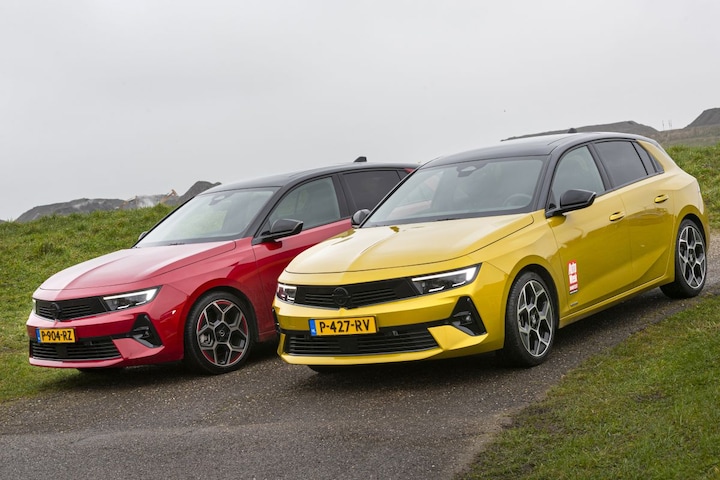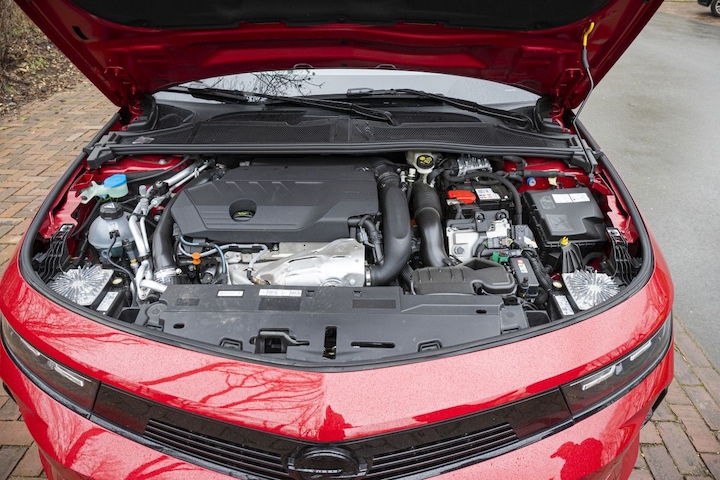Three-cylinder or a PHEV?

We like our Opel Astra endurance tester with its compact 1.2 turbo engine, but wouldn’t it be nicer with a lot of extra electrical power? We put the 1.6 Turbo Hybrid 180, a plug-in hybrid, next to it.
Why are there so many different powertrains for the Opel Astra?
All brands come up with their own strategy for the implementation of electrification. Some wait as long as possible with plugs, others have their own line-up for plug work. At Stellantis they try to bring everything under one face as much as possible. For example, the electric Opel Corsa and the Peugeot 208 can hardly be distinguished from their petrol brothers. A fully electric version of the Opel Astra will soon be available that differs little in its design from, for example, our Astra endurance tester. They are all on the same platform. There is also a middle ground: a plug-in hybrid.

Is the 1.2 Turbo with 130 hp powerful enough for the Astra?
Now we just have the Opel Astra in the second best form in our garage: a 1.2 three-cylinder with 130 hp and automatic transmission. It’s the engine we’ve found in various Peugeots and Citroëns for many years and you can also get it in the Astra with 110 hp. As the new boy in the group, Opel can now also use it. We are very pleased with our Astra, apart from some recurring quarrels with the multimedia system, but it is of course interesting to see if it is not better to save for the version with a plug that is considerably stronger. However, as long as the speed is not kept too low by the automatic transmission, the 130 hp is more than enough.

How much power does the Astra with plug-in hybrid powertrain have?
But more power is always better, right? That is why we have placed a beautiful red Astra 1.6 Turbo Hybrid 180, the Astra PHEV with a system power of 180 hp, next to our also beautiful golden endurance test. There is also a 225 hp variant of the same powertrain, but then it is automatically a sportier Astra GSe. It is a fine version with nice red wheels that match the paint. The car looks nice and thick in this version, almost as if it has a sports package. This is partly due to the Black pack, which is part of the Level 4 version of the test car. The black roof, black accents and darkened rear windows can also be found on our endurance tester, which does miss the color in the wheels. A separate option for those who would like to see it differently.

Were you already satisfied with the Astra 1.6 Turbo Hybrid before?
The plug-in Opel is not completely new to us, because the first Astra of this generation that we tested on Dutch soil was such a plug-in hybrid. A car that scored well and managed to stay ahead of a Peugeot 308 and Volkswagen Golf in an indirect comparison. How is he doing against his own brother today? For the sake of clarity, the specifications: the 1.6 Turbo Hybrid has a 1.6 four-cylinder with turbo with 150 hp and an electric motor with 110 hp. These are mainly intended to drive side by side. The system power is therefore a lot lower than you would think: 180 hp. Even so, that is considerably more than the 130 hp of our endurance tester and that is reflected in the sprint figures.

With 180 hp, the Astra Turbo Hybrid is surely much faster than the 1.2 Turbo?
That was not that bad. The fact that the car is not as fast as you would think with this power is due to its higher weight. All electrical components and especially the batteries provide 300 kilos extra compared to our endurance tester. That is a significant difference and if you switch, it is noticeable. Nevertheless, at the first meeting we found that the PHEV felt particularly light-footed for a plug-in compared to comparable cars from other brands. We still support that claim, but this indicates just how light the Astra is in principle. Our endurance tester is really a relief between testing all kinds of electric cars. That is more than the paper weight of 1,271 kilos. It’s also about how the chassis handles it. It makes sense that the plug-in feels heavier, but in its kind, the Astra still does very well.
What good is that 180 hp in practice?
Still, the higher power does not really pay off, because if you plug in and drive electrically, you basically only have 110 hp. So 20 hp less, while the car is heavier than our golden Astra. If the battery is empty, you will not have the full 180 hp again. The fact that the Astra is faster on the traffic light sprint with both engines working is nice on paper, but fairly useless in practice. So for the horsepower you don’t have to make the step. The cooperation between the two engines is very smooth and a lot better than in the average PHEV, where the combination of forces is sometimes accompanied by some shocks. We also experienced this in the 308 Hybrid 180.

Is the Astra Turbo Hybrid more economical than the 1.2 Turbo if you don’t plug it in?
Remarkably enough, both cars score almost the same if you only drive on petrol. Then we arrive at 6.5 liters per 100 kilometers (1:15.4). A neat performance from the PHEV, which clearly knows how to make good use of its hybrid powertrain. Remarkably enough, we scored less well with our Peugeot 308 endurance tester using the same technology. Nevertheless, the three-cylinder endurance tester scores even better, which comes out at 6.2 liters per 100 kilometers (1:16.1). There may have been minor updates in the meantime. This means that with good plugging you can quickly drive very cheaply, especially if you get your electricity cheaply with, for example, solar panels. Incidentally, with the test car we come 50 kilometers away on a charge of electricity. The factory specification is 67 kilometers. During the test week it was 10 degrees Celsius.

What does an Astra with plug-in hybrid powertrain cost and what does the endurance test cost?
The Turbo Hybrid must compensate for a nice additional cost. Despite the lower bpm, the red PHEV is more expensive. Now our endurance tester is a thick Ultimate version, which is no longer available, so that is somewhat difficult to compare. The red PHEV that we have briefly as a guest is an Astra 1.6 Turbo Hybrid 180 hp in Level 4 trim. A 130 hp version with automatic transmission in the same Level 4 version costs €41,749, the PHEV without extra options €44,749. So you have to make up €3,000 in petrol with electricity. Not an impossible task if you drive the car for years and you can (and want to) charge well everywhere. From a purely economic point of view, it therefore pays to go for the plug-in, but if we look purely at the driving, then the ‘simple’ petrol version is just right us actually better. The red Astra drives above average for a PHEV, but that is more because the Astra drives above average anyway. The simplicity of our 130 hp endurance test translates into driving pleasure and that is worth something. In terms of ease of use, it also makes a difference: the trunk of the PHEV is 70 liters smaller due to the batteries. Not an extreme difference, but it would just make a big difference when you go on vacation.
.
– Thanks for information from Autoweek.nl